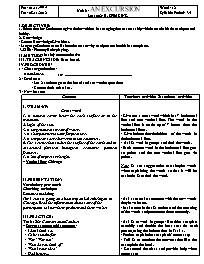Giáo án English 10 - Unit 6: An Excursion - Lesson 2: B.Speaking - Năm học 2012-2013

I. OBJECTIVES:
1. Education aim: Students can give their own ideas in arranging the seats on a ship which are suitable for each person's hobby.
2. Knowledge:
- General knowledge: Give ideas.
- Language: Students can talk about the reason why each person should sit at one place.
3. Skills: Fluency. Role- playing.
II. METHOD: Mainly communicative.
III. TEACHING AIDS: Extra board.
IV. PROCEDURE:
1 / Class organization:
10: .
Attendance:
2 / Oral test:
- Let 2 students go to the board and answer the questions
- Correct their mistakes.
Bạn đang xem tài liệu "Giáo án English 10 - Unit 6: An Excursion - Lesson 2: B.Speaking - Năm học 2012-2013", để tải tài liệu gốc về máy bạn click vào nút DOWNLOAD ở trên
Pre : 01.11.2012 Tea: 08.11.2012 Unit 6 : AN EXCURSION Lesson 2: B. SPEAKING Week: 12 Syllable Period: 34 I. OBJECTIVES: 1. Education aim: Students can give their own ideas in arranging the seats on a ship which are suitable for each person's hobby. 2. Knowledge: - General knowledge: Give ideas. - Language: Students can talk about the reason why each person should sit at one place. 3. Skills: Fluency. Role- playing. II. METHOD: Mainly communicative. III. TEACHING AIDS: Extra board. IV. PROCEDURE: 1 / Class organization: 10: ................................................................... Attendance: 2 / Oral test: - Let 2 students go to the board and answer the questions - Correct their mistakes. 3 / New lesson: Contents Teacher/s activities & students/ activities I. WRAM-UP: Crossword 1. A natural cavity below the each surface or in the mountain. 2. Light of the sun. 3. A large natural stream of water. 4. A short journey usually for pleasure. 5. A temple or sacred tower in Asian countries. 6. The science that studies the surface of the earth and its associated physical, biological, economic, political features. 7. A hill of impressive height. * Vertical line: Chicago II. PRESENTATION: Vocabulary pre- teach Checking technique Sentence modeling Tim's class is going on a boat trip on Lake Michigan in Chicago. Read the information about some of the participants to know their problem and their wishes III. PRACTICE: Task 1&2- Conversation Conduct * Suggest some useful structures: - I don't think so. - To be suitable for - Why? Why not? - What do you think of? - What's your idea? - Had better... IV. FURTHER PRATICE: Task 3- Giving Reasons *Suggested answers A: I think seat 1 is most suitable for Mary. B: Why? C: Because she suffers from travel sickness so she can get lots of fresh air from that seat. D: Yes. Put her in seat 1. What about John? A: I don't think so. John doesn’t like air- conditioning so put him in seat 37. He can take as many photographs as he likes. C: OK. I think Susan had better take the seat 10. What do you think? B: I think it's a good idea because she wants to be near Many. - Which seat do you think the most suitable for you? Why? Use information in Task 1 As suggestions. - Give out a crossword which has 7 horizontal line and one vertical line. The word in the vertical line is made up of 7 letters from the horizontal lines. - Give information/definition of the words in the horizontal line. - Ask Ss work in groups and find the words. - Each correct word in the horizontal line gets 10 points and the one vertical line gets 40 points. Note: Ss are suggested to use simpler words when explaining the words so that it will be easier for Ss to find the word. - Ask ss to make sentences with the new words they have learnt. - Make certain that Ss understand the meaning of the words and pronounce them correctly. - Ask Ss to work in groups: Read the seat plan carefully and decide the best seat for each person, using the information in Task 1. - Further explain the seat plan if necessary. - Tell Ss to conduct the conversation like the example in the book. - Go around the class and provide help when necessary. - Call on some groups to conduct the conversation in front of the class. - Comment and give suggested answers: - Tell Ss to work in pairs and discuss: - Call on some Ss to talk about their seat preference in front of the class. - Comment and make necessary corrections. 4 . Consolidation: 5 . Homework: - Summaries the main points. - Assign homework
Tài liệu đính kèm:
 B.Speaking.doc
B.Speaking.doc





